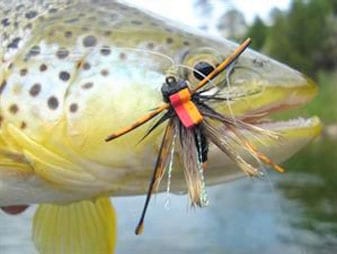What is the buzz about the bugs? It’s time for fly anglers to cast some big bugs under trees with a plop. Yep, not that gentle presentation that we often practice, but we want a “plop”. Now that doesn’t mean the line plops, but the fly plops. With that being said, what would change in our cast to get the fly to land first with a downward thrust rather than the line and fly landing at about the same time? What variables (power, stroke, timing, tragectory) would we change from a normal cast to deliver the fly first?
Let’s talk about the fly to begin with. It is a large floating fly, generally a black body, red wing and red eye that has a large profile about the size of a large bass popping bug, so it has some mass to it and a bit of wind resistance. Next, let’s talk about the leader that is going to carry the fly to the target. It needs to have a large mass profile to carry the energy from the fly line to the fly. Using a 1X or 0X is a good choice in a 7-8 foot length. Thrown on a 7 or 8 wt. rod and you are in good shape with a weight forward (WF) floating fly line.
Back to the cast. If you make a normal overhead cast with a few adjustments, you can get the fly to hit first. That plop imitates the cicada falling from the trees. To do that, increase the line speed to overcome the wind resistance of the fly and transfer more energy. Aim about 4 feet over the target. Stop the rod with a solid stop to get the line to kick over using the momentum of the fly and the resistance of the rod leg of the loop in the line to turn it over or ‘kick’ over. Then hang on. It could be a bass, carp, sunfish or catfish.
Hint; when you get ready to make your next cast, it will be easier to do if you use a spiral lift. Wondering what that is? Check out next month’s Casting Corner in The Angler Magazine.
